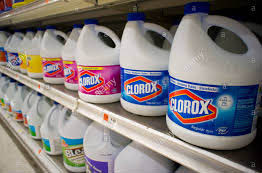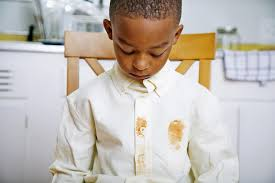BLEACH, HOT OR COLD WATER, WHAT WILL TAKE OUT THESE STAINS?


We have poled every uniform manufacturer we work with and it is unanimous: if you're wondering how to wash your scrubs, DO NOT USE CHLORINE BLEACH!
Even when asked about the white lab coats, they all say the same thing, if you feel you must use some type of bleach, it should be a non-chlorine color safe bleach. (This is super important for lab coats with your awesome monogram or other custom logo embroidery! Yes we can do that!)
So what about the good old fashioned way of getting white to look dazzling white? Plain and simple, according to the manufacturers the chlorine bleach is doing more harm to the fabric than good. (Not to mention the frustrating times when bleach residue is left in the washer and you put your favorite top in with the next load and it comes out with spots!) You can achieve the same level of bright white using the non-chlorine color safe bleaches available on the market today.
Laundering instructions for white lab coats:
Landau: Machine wash Cold . Do not bleach, Tumble dry warm . Remove promptly. Iron low heat setting
Barco / Grey's Anatomy: Machine wash warm with like colors. Use only non- chlorine bleach if necessary. Tumble dry low. Remove promptly. Iron low if necessary
White Swan / Meta : Machine wash warm with like colors; Permanent press cycle. Use only non-chlorine bleach. Tumble dry medium. Remove promptly. Warm iron if desired.
Cherokee / Dickies: Machine wash cold with like colors. Do not bleach. Mild soaps recommended. Tumble dry low.
MedCouture / Peaches : Machine wash cold with like colors. Do not bleach. Tumble dry low. Low iron, if needed. Do not dry clean.
WonderWink: Machine wash warm with like colors. No bleach. Tumble dry low. Warm iron when needed.
Koi: Turn garment inside out to wash and dry. Machine wash warm with like colors. Do not bleach. Tumble dry low, remove promptly.
Laundering instructions for colors:
Landau: Machine wash warm . Do not bleach, Tumble dry warm . Remove promptly. Iron low heat setting.
Barco / Grey's Anatomy: Machine Wash COLD with Like Colors Use Non-Chlorine Bleach If Necessary Tumble Dry Low Iron Low If Necessary
Jockey: Wash before wearing. Machine wash in cold with like colors. Use only non-chlorine bleach. Gently cycle. Tumble dry low. Remove promptly.
Cherokee / Dickies: Machine wash cold with like colors. Do not bleach. Mild soaps recommended. Tumble dry low.
MedCouture / Peaches: Machine wash cold. Do not bleach. Tumble dry low setting. Use cool iron, if necessary.
Koi: Turn garment inside out to wash and dry. Machine wash warm with like colors. Do not bleach. Tumble dry low, remove promptly.
White Swan F3 FKA Fundamentals: Machine wash warm with like colors, Permanent press cycle Use only non-chlorine bleach Tumble dry medium Remove promptly Warm iron if desired
( You can find laundering instructions for each item in the product description tab marked Fabric & Care.)
Ok, I think we have the hint. No chlorine bleach. So, what about those difficult stains?
You know it’s going to happen; soon after purchasing those fresh and oh so clean scrubs, something will spill and stain them. As a nurse or any medical professional, you spend your day dealing with the inevitable, body fluids, dyes and more of all kinds, so what are the magic secrets to getting all those stains out?
Sometimes you just don't have the freedom to rush to a sink and start soaking the stains, but when you can, get to the sink and start the stain removal process ASAP. Acting quickly will help from keeping the stains from settlings in.
Begin by blotting off all excess fluids and rinsing with the correct water treatment based on the type of stain. Knowing the best practices for removing the common medical stains will save you many scrubs over the long haul. We've gathered just a few of the most common scrub stains and what to do to get them clean again!
Blood Stains: Start by soaking in COLD water. Avoiding hot water will help from keeping the blood settling in further. Rub in a bit of heavy duty laundry detergent, one with enzymes (Tide, or many other common household brands are perfect for this!). Let the detergent sit for 10 minutes, and then wash as normal. Before you dry your scrubs, make sure to check for any stain remainders, and treat again if needed. Blood can be one of the trickiest stains to remove.
Medications: Many medications are mixed with an added dye – you'll need a color safe bleach solution for getting the dye removed from your scrubs. Soak the garment for up to 8 hours in the beach and wash with WARM water as normal.
Vomit and Feces: Much like blood stains, these should also be treated as quick as possible with COLD water to help break down and wash away the stains. Avoid rubbing with a cloth or any other objects to keep the stains from being pressed deeper. Again, flush with a steady stream of cold water and spot- treat with a laundry detergent before washing. Got a funky odor along with the stain? Add in ½ cup of baking soda or distilled white vinegar to the wash.
Ointment: The dreaded oil based stains qualify for a HOT water treatment. Again, apply a heavy laundry detergent spot treatment. After letting the detergent soak in for 10 minutes or more, wash through a full cycle in HOT water.
How to Remove Laundry Stains With Vinegar By Erin Huffstetler April 30, 2017
https://www.thebalance.com/how-to-remove-laundry-stains-with-vinegar-1387973
Not much beats the stain-fighting power of vinegar. Learn how to treat 13 of your toughest laundry stains with distilled white vinegar and just a bit of elbow grease.
1 Tomato Stains
Saturate the tomato stain with vinegar and allow it to soak in. Then, launder as usual. Check to make sure the stain is out before you run it through the dryer.
2 Mildew Stains
If you forgot to move the wash over to the dryer, and it smells mildewy or has visible mildew stains, just mix equal parts vinegar and water with some salt, and soak the clothing in the solution. This should lift mildew stains from most fabrics. If you still see signs of staining after soaking, make a solution of undiluted vinegar and salt, and soak it again.
3 Coffee/Tea Stains
To banish coffee or tea stains, soak the stained fabric in 1/3 cup vinegar mixed with 2/3 cup water. Hang the garment outside in the sun to dry, then launder as usual.
4 Mustard Stains
Mustard stains require a bit of persistence. Start by applying undiluted vinegar to the stain. Then, allow it to soak in. If that doesn't do it, you may also need to treat the spot with laundry detergent. Just work it into the stain. Then, throw it in the wash. Check to make sure the stain is out before you dry the garment. Repeat the process, if necessary.
5 Sweat Stains
To banish sweat stains, pour vinegar over the discolored area, and rub coarse salt into it. Table salt will work if it's all you have. Place the garment out in the sun to dry; then, wash it.
6 Grass Stains
To lift grass stains, soak the garment in undiluted vinegar for 30 minutes; then launder it. If you can still see signs of the stain after washing, try making a paste of vinegar and baking soda. Use an old toothbrush to coat the stain; then launder it again.
7 Ink Stains
Defeat stubborn ink stains by spraying the stain with hair spray; then, dab vinegar on the hair spray to remove it -- and the ink. Nifty!
8 Blood Stains
Fast action is the cure for bloodstains. Pour vinegar over the stain, and allow it to soak for 15 minutes. Then, rinse with cool water, and repeat if necessary. Wash immediately.
9 Set-in Stains
Saturate set-in stains with vinegar. Then, rub the spot with a paste made from equal parts vinegar and baking soda. You can add a couple tablespoons each of vinegar and laundry detergent to a bucket of water and soak the garment overnight if the stain persists. Then, rinse and wash.
10 Crayon Stains
Rub vinegar into the crayon stain with a brush -- an old toothbrush works great. Then, toss the garment in the wash.
11 Vomit Stains
Rinse the garment in cool water to remove as much of the vomit as possible. Then, soak the stain in vinegar, and wash the garment. Repeat the process, if necessary.
12 Rust Stains
To remove a rust stain, soak a cotton ball in vinegar, and use it to blot the stain. Cover the stain with a thin layer of salt, and rub it into the vinegar and the fabric. Lay the garment outside in direct sunlight until the stain has faded. Then, wash as usual.
13 Iron Scorch Marks
Accidentally leave the iron on your clothes for too long? Reverse the damage by soaking a cotton ball or rag in vinegar, and use it to dab at the scorched area. Blot the stain with a clean rag, and this should lift the stain. It may take more than one application to fully remove the scorch mark.
Can you get stains out of clothes after they've been washed?
One of the simple, unavoidable facts of life is that stains happen, no matter how careful we are with our glasses of red wine or simmering pans of spaghetti sauce. Unfortunately, every stain reacts differently to the myriad cleaning methods out there, so success isn't guaranteed on the first try, even if you do everything right from the very moment the blemish occurs. Many people throw in the towel, so to speak, after the garment in question has been put through the washing machine to less than stellar results. There's no need to give up on your favorite tee, though! Whether your pretreatment failed or you simply didn't notice the stain before tossing it in the wash, there are plenty of ways to eliminate pesky blemishes. In fact, almost all stains will come out with some extra elbow grease (pun intended). So lather, rinse and repeat as much as necessary, using any or all of these handy tips and tricks!
My go-to stain removal technique is appallingly easy. Just rub a little bit of liquid detergent directly onto the stain, let it soak in and then run it through the washer again. Some experts swear by liquid dishwashing detergent used in the same fashion. Hey, it's all soap, right?
Stain-removal sprays and sticks have come a long way in recent years. A squirt or two of the good stuff usually does the trick. Just make sure you follow the given directions or it won't be as effective.
For grease marks caused by substances like salad dressing or cooking oils, simply rub a stick of white chalk into the stain to absorb the offending spot and then run it through the washer again.
Adding baking soda to the wash and then running the garment through again is another effective method for getting rid of oil or grease stains.
If that annoying oil stain still hasn't budged, consider rubbing some corn starch directly into it and washing it yet again.
Occasionally, kids or crafty adults get a little overzealous with glue sticks -- and their clothes pay the price. Unfortunately, glue can leave a stain even after the substance has been peeled or scraped off. Acetone, which is found in nail polish remover, is generally very effective at getting rid of glue-based blemishes. Make sure the fabric you're treating is colorfast and machine washable, though, since acetone can cause the fabric to become further discolored.
Bleach is very harsh and often less effective than most stain removal aids, so try to avoid using it when possible. If you feel like it's your only option, though, start with diluted oxygen bleach and move on to chlorine bleach if necessary.
Really old, stubborn stains sometimes respond best to liquid glycerin. Rub it in, let it soak and then launder again.
Whatever you do, try to avoid putting stained items in the dryer because the heat often causes the discoloration to set permanently.
Quick Tips for Removing Stains from Clothing
BY THE EDITORS OF PUBLICATIONS INTERNATIONAL, LTD. & RACHAEL SCHULTZ
To remove spots of blood from clothing, use 3 percent hydrogen peroxide -- the kind you find in the first-aid section of the store. Soak the stain with the peroxide, use your fingernail or the blade of a butter knife to help loosen and scrape away the blood, then rinse it away with more hydrogen peroxide. In most cases, you'll have better luck removing stains -- especially blood stains -- if you treat them immediately after they happen, before the stains have a chance to dry.
Another method for removing blood from clothing is to wet the stained area of the fabric with water, sprinkle it with plain old table salt, rub one half of the stain against the other to work in the salt and loosen the stain, then immediately launder the garment the way you usually do.
Grass stains on clothes can be removed with an old toothbrush and plain white toothpaste; just make sure you use a paste variety and not a gel. Squeeze a small amount of the toothpaste onto the stain, then dip the toothbrush in clean water and use it to scrub away the stain. Repeat this process as needed to treat all of the stain(s). Rinse the area and launder the clothing as usual. Now you can steal home plate without a second thought.
To banish a ring around the collar…
Whether it's on work shirts or Sunday best, staining around the collar can be easily vanquished with a touch of something you're pretty much guaranteed to have in the house -- shampoo. Just pour a little shampoo -- any shampoo will do, even the inexpensive, generic kind -- onto the collar, rub the collar together to work the shampoo in well, and rinse thoroughly. Then launder as usual.
To remove lipstick from dark fabrics, grab a piece of white bread and remove the crust. You don't have to forgo a sandwich; you can use the heel of the loaf -- no one likes that piece anyway. Wad up the soft center and rub it gently on the stain until it picks up all of the lipstick. Sweep away any leftover crumbs with a clean, soft-bristled brush.
To remove grease spots, Sprinkle the spot with cornstarch. Allow the cornstarch to soak up the grease for a few minutes, and then brush it away. The grease spot will lift right out, and you can get back to trying to convince everyone to use napkins instead of their clothes.
Oily stains from natural body oils can be removed with plain shampoo (just like oil in your hair). It's that easy. Just pour some on the stained areas, rub it in, rinse thoroughly and launder the garment as usual.
If you get ink on a piece of clothing, try soaking the ink mark with rubbing alcohol and wiping it away with a clean, white cloth. Another old-fashioned remedy for removing ink marks from clothes and other fabrics is to wet a sponge with milk and rub the ink stain until it disappears.
To remove tea stains: Mix up a concoction of heavily sugared water by stirring the water as you add sugar to it. Keep adding sugar until it no longer dissolves (warm water makes it easier for sugar to dissolve). To remove tea stains from clothing or table linens, submerge the stained area for several minutes in a small container of the heavily sugared water, then launder as usual.
We have not tried all of these tips for stain removal, so let us know what works for you and we may include you and your idea in a future blog!














